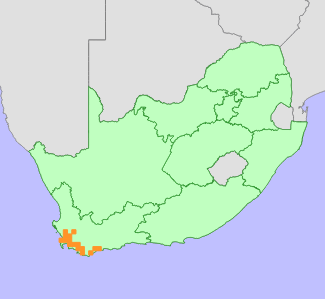|
Scientific Name | Hypodiscus rugosus Mast. |
Higher Classification | Monocotyledons |
Family | RESTIONACEAE |
Synonyms | Hypodiscus paludosus Pillans, Hypodiscus parkeri Pillans, Hypodiscus tristachyus Mast., Hypodiscus zeyheri Mast. |
National Status |
Status and Criteria | Endangered A2c; B2ab(i,ii,iii,iv,v) |
Assessment Date | 2013/09/19 |
Assessor(s) | L. von Staden & N.A. Helme |
Justification | A widespread (EOO 11 731 km²) and formerly common species that is estimated to have declined by at least 50% within the past three generations (generation length 50 years), due to more than 80% habitat loss to agriculture, urban expansion and alien invasive plants. Between 10 and 15 severely fragmented subpopulations remain on isolated fragments of lowland renosterveld (AOO <500 km²), and continue to decline. |
Distribution |
Endemism | South African endemic |
Provincial distribution | Western Cape |
Range | Malmesbury and Tulbagh to the Cape Flats, also occurring on the Agulhas Plain as far east as Potberg. |
Habitat and Ecology |
Major system | Terrestrial |
Major habitats | Swartland Shale Renosterveld, Breede Shale Renosterveld, Eastern Ruens Shale Renosterveld, Central Ruens Shale Renosterveld, Western Ruens Shale Renosterveld, Peninsula Shale Renosterveld, Swartland Granite Renosterveld, Elgin Shale Fynbos, Potberg Ferricrete Fynbos, Elim Ferricrete Fynbos, Lourensford Alluvium Fynbos, Swartland Alluvium Fynbos, Breede Alluvium Fynbos |
Description | Seasonally damp, sandy or clay flats in lowland renosterveld. |
Threats |
| Less than 15% of lowland renosterveld within this species' known range remains after extensive loss to crop cultivation and urban expansion. Large areas of this species' remaining habitat is also invaded by dense stands of alien plants, particularly around Malmesbury and on the Agulhas Plain. Habitat loss is continuing. |
Population |
Hypodiscus rugosus is a formerly widespread and common species that has lost more than 80% of its habitat within the past three generations. This long-lived, ant dispersed resprouter now remains in between 10 and 15 isolated fragments, and is now considered very rare. Subpopulations at between 30 and 50% of locations known through historical records are now locally extinct, and considering the extent of habitat loss, it is estimated that the population has declined by at least 50% in the past three generations (generation length estimated to be at least 50 years).
|
Population trend | Decreasing |
Assessment History |
Taxon assessed |
Status and Criteria |
Citation/Red List version | | Hypodiscus rugosus Mast. | EN A2c; B2ab(i,ii,iii,iv,v) | 2014.1 | | Hypodiscus rugosus Mast. | Least Concern | 2013.1 | | Hypodiscus rugosus Mast. | Least Concern | Raimondo et al. (2009) | | Hypodiscus rugosus Mast. | Not Threatened | Hilton-Taylor (1996) | | Hypodiscus paludosus Pillans | Endangered | Hall et al. (1980) | |
Bibliography |
Goldblatt, P. and Manning, J.C. 2000. Cape Plants: A conspectus of the Cape Flora of South Africa. Strelitzia 9. National Botanical Institute, Cape Town.
Hall, A.V., De Winter, M., De Winter, B. and Van Oosterhout, S.A.M. 1980. Threatened plants of southern Africa. South African National Scienctific Programmes Report 45. CSIR, Pretoria.
Hilton-Taylor, C. 1996. Red data list of southern African plants. Strelitzia 4. South African National Botanical Institute, Pretoria.
Linder, H.P. 2011. The African Restionaceae: an Interactive Key identification and description system. Version 6. http://www.systbot.uzh.ch/Bestimmungsschluessel/Restionaceae_en.html. Downloaded.
Raimondo, D., von Staden, L., Foden, W., Victor, J.E., Helme, N.A., Turner, R.C., Kamundi, D.A. and Manyama, P.A. 2009. Red List of South African Plants. Strelitzia 25. South African National Biodiversity Institute, Pretoria.
|
Citation |
| von Staden, L. & Helme, N.A. 2013. Hypodiscus rugosus Mast. National Assessment: Red List of South African Plants version 2024.1. Accessed on 2025/10/14 |
 Comment on this assessment
Comment on this assessment


